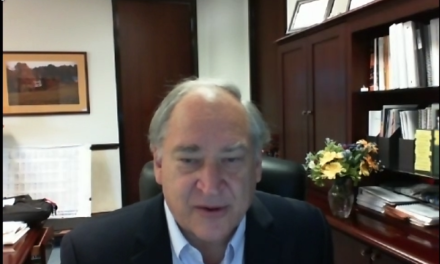By Megan Poinski and Len Lazarick
Megan@MarylandReporter.com
Len@MarylandReporter.com
Racial politics and concerns about community cohesion dominated a three-hour hearing Thursday as scores of people from across Maryland came to Annapolis to condemn, offer suggestions and even praise the new legislative district map drawn by Gov. Martin O’Malley’s Redistricting Advisory Committee.
The map, which was the product of census data and comments from a dozen hearings across the state this summer, was first unveiled online last Friday. O’Malley said he had the hearing to give the people a chance to see and comment on it before he sends it to the General Assembly next month.
O’Malley listened to all of the testimony and said no one would likely say that the new map was better than the old one, but it was made necessary by shifting populations found in last year’s census. He said he would try to address as many concerns as possible before finalizing the map and presenting it to the legislature.
“We are all in this together, and there is no change in one district that does not affect another district, one neighborhood that does not affect another,” O’Malley said.
Afterward he told reporters, “Of course, I’m open to making tweaks. … This is a real process.” But “I don’t expect it to change very much.”
Senate President Mike Miller, a member of the redistricting committee, promised that once O’Malley revises the map and passes it along to the General Assembly next month, there would be another public hearing on the proposed district lines.
More minority districts demanded
In sometimes emotionally charged testimony, committee members heard several African-Americans asking for more districts where they would be in the majority.
Carletta Fellows of the Fannie Lou Hamer political action committee – which is currently challenging the congressional redistricting map in federal court – did not mince words when she talked about the map. She called it “a miscarriage of justice” and should show “greater sensitivity to the black and brown community.”
Del. Tiffany Alston, D-Prince George’s County, said that looking at the demographics of the state, there should be 14 senatorial districts with a majority of black residents. She said she would not be happy with a map that doesn’t give African-Americans the appropriate voting strength in the state.
“As a Democrat, I find this map to be a slap in the face to black Democrats,” she said.
Sen. Anthony Muse, D-Prince George’s, said that Maryland’s non-minority white population declined to nearly 55% — yet the proposed map seems to over represent whites.
Del. Aisha Braveboy, D-Prince George’s County, chair of the redistricting committee of the Legislative Black Caucus, pointed out some problems she saw in districts in her county. Nearly 86% of the population in the 24th District – which includes Glenarden, Seat Pleasant and Fairmount Heights – is black. Meanwhile, there are other districts that could be drawn with stronger black majorities, but aren’t.
Sen. Delores Kelley, D-Baltimore County, said the proposed map moves her own District 10 in western Baltimore County into more rural areas with fewer African-Americans, in order to create a district shared with Baltimore City.
Elbridge James, speaking to the committee on behalf of the NAACP, asked O’Malley and his committee to take the comments about minorities into consideration.
“If these issues are not addressed, the participation opportunities of African-Americans will be severely limited, and this will stand for 10 years,” James said, until the next census.
Andy Carruthers, a white Prince George’s resident, took an opposite view, saying that looking so closely at race to draw district lines was “terribly harmful.” Though some people may vote solely based on a candidate’s race, that is not the way it always happens.
“Have we learned so little from the last presidential election?” Carruthers asked.
Keep communities together
Several residents of smaller communities, startled to learn that the proposed district lines bisected their neighborhoods, pleaded with committee members to keep their hometowns intact.
Lake Arbor, a small community in Prince George’s County near FedEX Field, is proposed to be split between the Districts 24 and 25. Angry residents met with Braveboy and Del. Dereck Davis to ask for their hometown to stay in one district. Braveboy presented the committee with a redrawn map that would accomplish this, and several long-time residents testified before the committee.
Lake Arbor resident Brian Austin said he is sure there was no malice intended when the map divided the community, but it upset him all the same.
“Division of an otherwise ideal environment makes no sense,” he said. “Division of a community that works together makes no sense.”
Eric Rockel, president of the Greater Timonium Community Council, was upset that the map did not put Timonium back together. The current districts split the Baltimore County community along I-83. While it is not an ideal situation, Rockel said that using the highway as a boundary makes sense.
The proposed map, however, still bisects Timonium – but no longer uses the highway as a boundary.
“My emotions went from disappointment to disillusionment to cynicism when I read the governor’s press release,” Rockel said. “He said he kept communities together, but not Timonium.”
Residents from Woodmore and Lanham-Seabrook in Prince George’s County had similar complaints.
Republican Dels. Cathy Vitale and Tony McConkey asked that Severna Park in Anne Arundel County not be split in three districts as proposed.
Some were satisfied
Though there were fewer people who said they were pleased with the map as drawn, some did come out to the hearing solely to praise the work of the committee.
Howard Gorrell, who attended all 12 statewide hearings of the redistricting committee, said he liked the way that district lines were drawn in Western Maryland, in keeping with testimony at the hearings.
Del. Ana Sol Gutierrez, D-Montgomery County, had some negative things to say about the plan, but was thankful that the committee paid attention to the emerging Latino population with a possible single-member majority district in Montgomery County.
Charles Berman of Derwood said that the last 10 years – when illogical district lines split up his hometown – were not good. However, Derwood is in a single district again on the proposed map.
“Thank you so much,” Berman said.







I wonder if it would be ok for whites to have white districts? Why do these black and hispanic advocacy groups constantly whine about how evil and racist whites are, yet these same people want racial benefits and districts only for blacks, hispanics, asians, etc? That’s what I call hypocrisy at its finest.
First our President promotes class warfare and now we have segments of the community promoting racial warfare. I have friends that are black and brown and yellow etc. They think of themselves as AMERICANS. I have a heavy Scottish and Irish genetic history but I am an AMERICAN FIRST.
It is a shame that we cannot seem to love our neighbors and give those that need it a hand UP and not a HANDOUT. I am tired of the crying and complaining when the whiners are lucky to live in a free society where there is no limit to what a person willing to work for it can do.
I believe it would be a good idea to go popular vote and dump the Electorial College concept.
With all of this focus on race in redistricting, can someone explain to me what is going to happen in a few years when *everyone* is a minority in places like Baltimore County? Will we create special “white” districts too? And what will happen to races that are not geographically concentrated, like Asians?
Multiracial and multireligious nations don’t work, especially in the long run. Each group will fight for power and blame the other one for their problems, etc. Notice that Japan or Finland or Iran doesn’t have race riots? Notice it’s only white countries that are required to have massive (nonwhite) immigration? Notice nobody is flooding Japan, China, Africa, Korea and other non-European countries with immigrants and demanding the native there abolish their culture and embrace the immigrants’ culture? I think, unforuntately, in 20 years or so we will be like the Balkans. We might have areas of the US that are white only, parts that are black only, the southwest being hispanic only, etc.
The new map “was a product . . . of comments from a dozen hearings”? Give me a break. Miller, Busch and O’Malley gave no weight to anyone’s testimony. They protected most incumbents, including some Republicans. But they cynically and arrogantly punished a few incumbents like Democratic Sen. Jim Brochin to ensure that the Democratic rank-and-file toe the party line in the future rather than represent the interests of their constituents. The result: Dem leaders win, most low-ranking Dems are safe-but-muzzled, many Reps are safe-but-ineffectual, and every voter in the state of Maryland is a big loser. Megan and Len, you missed the real story here by a mile. Very disappointing.
I thought I covered some of those issues in Monday’s analysis.
Len- You mentioned Brochin’s name midway thru , sure. But Monday you buried the lede, devoted most of the first three paragraphs to Miller/Busch talking points, and your bland language camouflaged what M and B were really doing and gave undeserved cover to Miller and Busch. I’m still disappointed in your coverage.